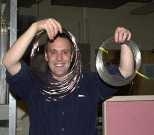MIT researchers have created high-performance mirrors in the shape of hair-like flexible fibers that could be woven into cloth or incorporated in paper.
Potential applications include fabrics with embedded bar codes that identify the wearer--useful in the battle suits of future soldiers--or a lightweight cloth that reflects radiation, protecting from blasts of heat. These mirrors also could be used as filters for telecommunications applications.
The work builds on the omnidirectional dielectric reflector (dubbed the "perfect mirror") created in 1998 by Yoel Fink, now an assistant professor in the Department of Materials Science and Engineering; Edwin Thomas, the Morris Cohen Professor of Materials Science and Engineering; and John D. Joannopoulos, the Francis Wright Davis Professor of Physics.
PERFECT MIRROR
The perfect mirror combined the best characteristics of the familiar metallic mirror we gaze into with those of the dielectric mirror (see MIT Tech Talk, Dec. 9, 1998 ). The latter is a type of mirror composed of alternating layers of nonmetallic materials that allow much greater control over the mirror's reflectivity, but are polarization sensitive and can only reflect light from a limited set of angles. Dielectric mirrors are most commonly used in high-performance applications such as laser cavities, and for adding and dropping channels in telecommunications systems.
MIT's perfect mirror can reflect light from all angles and polarizations, just like metallic mirrors, but unlike its metal counterpart can also be "tuned" to reflect certain wavelength ranges while transmitting others.
As a result, an array of mirror fibers or even a single fiber can be "tuned" to reflect light at different wavelengths to create a kind of optical bar code that could be woven into fabric or incorporated into a paper to identify the wearer, for example. Fibers could also be designed to reflect thermal radiation over various ranges. The resulting fabric could be cut into a protective suit.
"We've opened a new avenue of applications for these high-performance optical devices," said Shandon Hart, a graduate student in the Department of Materials Science and Engineering (MSE) and lead author of a paper on the work that appeared in Science Magazine on April 19.
Hart's co-authors are Joannopoulos and Fink; MSE graduate student Garry Maskaly; Burak Temelkuran, a postdoctoral associate in the Research Laboratory of Electronics; and Peter H. Prideaux, a research affiliate of the Research Laboratory of Electronics.
Polymer fibers alone have been quite successful commercially with ubiquitous applications stemming from their superior mechanical properties and low cost. They've been optimized for everything from strength to moisture resistance (think of a name-brand raincoat), yet little has been done to control their optical properties, said Fink, leader of the current research team. To address that challenge, the Fink team created a polymer fiber that is essentially sheathed with 21 layers of alternating index of refraction forming a cylindrical perfect mirror.
HOW THEY DID IT
"Just as in the movie 'Honey, I Shrunk the Kids,' wouldn't it be wonderful if you could fabricate something on the macroscale, then shrink it to a microscopic size?" said Fink. "That's what we did. But the magic shrink-down apparatus we used is not a 'shrinking beam' from science fiction ... it's a furnace."
The team first created a macroscopic cylinder, or preform, some 20 to 30 centimeters long by 25 millimeters in diameter. It contained the same 21 layers of dielectric materials surrounding a polymer core as the final fibers, but unlike the microscopic features of the ultimate fibers, each layer of the preform could be seen with the naked eye.
The preform was subsequently fed into a tube furnace that is part of an optical-fiber draw tower recently constructed in the Fink lab. From there, it was drawn into hundreds of meters of thread-like fiber with 21 microscopic layers. Each layer is only a few hundred nanometers thick, thus spanning nine orders of dimensional magnitude in a single processing step.
"The amazing thing is that the resulting fiber retained the same structure as the macroscopic preform cylinder over extended distances," said Fink.
Key to the success of the drawing process is the identification of a pair of materials which have substantially different indices of refraction yet similar thermo-mechanical properties that enable them to be thermally processed at the same temperature.
Fink notes that drawing fibers is a process commonly used to create the glass threads of fiber optics. But while the typical glass thread has only a few, fairly large internal features, the mirror threads have over 21 features and the thickness control is well below one micron. "So we're taking the process a step further and getting very high control over the microstructure of the fiber with a very small number of defects overall," he said.
This work was sponsored by the Defense Advanced Research Projects Agency, the U.S. Department of Energy, and the National Science Foundation, and is a Seed Project through MIT's Center for Materials Science and Engineering (CMSE). The authors would like to acknowledge help from Bill Smith and Mary Young in the Research Lab of Electronics, Gerry Hughes from MSE, and the CMSE Shared Experimental Facilities.
A version of this article appeared in MIT Tech Talk on April 24, 2002.






